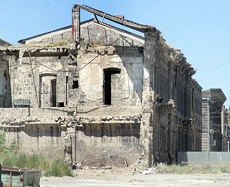Gyumri is a symbolic city where the past and the present mix and create a special environment. Sheep are grazed near a broken-down factory, the “Seven Wound” church is being renovated located near the former KGB building. You pass “cottages” as you walk by the “Gorki” park , say hi to your friends, ask the ill about their health and then continue your road…Most of the people in Gyumri trade and that’s how they make a living. What does the youth do? My interviewee named Lilit thought about this for a long while, shrugged her shoulders and said: “Nothing”.
The Gyumri market is full of a variety of fruits and vegetables. The people hurrying to buy products makes it hard for you to look ahead and the sidewalks are hard to walk on. A woman asks the price for a product, grabs her child’s hand and walks away complaining. The price was expensive.
-Hey sister, how much does that camera cost?” they ask me as they see me with the camera.
-How much do your apples cost?”
“I’ll sell it to you for 300 drams a kilogram. You’re not from Gyumri?”
“Come here and I’ll give you the same apple for 150 drams, look how good it is,” says the female seller next to the man, gets up from where she was sitting and without waiting fills my bag.
The Gyumri square is not too far from the market. Some men are sitting on the steps of a restaurant building and “chewing” sunflower seeds and looking towards the square. Three women are walking alongside a dry fountain. The cinema building and the church are behind that fountain.
 “Before, when we used to enter our square, there were so many people that you could barely make your way through, but now you won’t see anyone at any hour of the day. The markets and fairs are the only places where you will find a lot of people. It will get really worse if things go on like this,” says Rubik Harutyunyan from Gyumri. He is the first doctor of Gyumri’s first hospital’s injury department and has a 40-year experience. Mr. Harutyunyan has spent most of his life in Gyumri and has witnessed most of the events that have taken place.
“Before, when we used to enter our square, there were so many people that you could barely make your way through, but now you won’t see anyone at any hour of the day. The markets and fairs are the only places where you will find a lot of people. It will get really worse if things go on like this,” says Rubik Harutyunyan from Gyumri. He is the first doctor of Gyumri’s first hospital’s injury department and has a 40-year experience. Mr. Harutyunyan has spent most of his life in Gyumri and has witnessed most of the events that have taken place.
“Whereas before Gyumri had a 250-270,000 population, now there are barely 150,000 people living in the city, “he says.
Besides the increase in emigration, there are more deaths and illnesses. The intestinal tract illnesses are the most widespread.
“They put the food on the ground and sell it. It’s the same thing day after day; there is no intoxication. At least the markets have to be clean,” says the worried doctor, stays silent and adds:
“The main reasons for all illnesses are food and stress. People don’t have the opportunity to buy what’s needed.
Besides stomach illnesses, people also complain about side pains.
“There hasn’t been a day when I haven’t had tens of patients. I think that the illnesses began back during 1993-1994 as a result of the lack of heating.”
As Mr. Harutyunyan said, doctors have left Gyumri a long time ago. Today, there are sixteen doctors working at the hospital, while they cure forty people a month.
 “You know, Armenians always compare Gyumri with the ancient city of Ani. Ani was destructed in 1300, and we cry knowing that that city is part of Turkey now. Gyumri is like Ani; we shouldn’t just consider it an earthquake zone and be satisfied with that. The government should pay a little attention to what’s going on in Gyumri. Only God knows what’s going on.”
“You know, Armenians always compare Gyumri with the ancient city of Ani. Ani was destructed in 1300, and we cry knowing that that city is part of Turkey now. Gyumri is like Ani; we shouldn’t just consider it an earthquake zone and be satisfied with that. The government should pay a little attention to what’s going on in Gyumri. Only God knows what’s going on.”
Russian music is heard on the streets of Gyumri and it fades out the Armenian folk music. Kirov street is one of the most beautiful streets of Gyumri. There are numerous cafes, stores and there is greenery on the sidewalks. A homeless accordion player plays music on Kirov street. He has an open suitcase next to him, three certificates and some money.
“No matter how hard it is, hold on…”he sings as he’s unaware of passer-bys and the money that falls in.”

